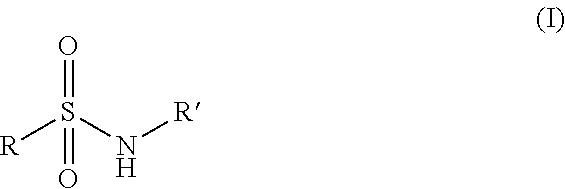Sulfonamide based polymers for copper electroplating
a technology of sulfonamide and polymer, which is applied in the field of sulfonamide based polymers for copper electroplating, can solve the problems of uneven metal deposit between the surface and the aperture, difficulty in electroplating a substrate with irregular topography, and difficulty in achieving substantially uniform thickness metal layer, etc., to achieve good physical reliability, high throwing power, and good threw
- Summary
- Abstract
- Description
- Claims
- Application Information
AI Technical Summary
Benefits of technology
Problems solved by technology
Method used
Image
Examples
example 1
[0055]To a 100 mL round bottom three-neck flask equipped with a condenser and a magnetic stirrer, 5 mmol benzenesulfonamide was added followed by addition of a solution of 5 mmol poly(ethyleneglycol) diglycidyl ether (Mn 526) in 30 mL of ethanol. 5 mg K2CO3 was then added into the reaction mixture. The mixture was heated in an oil bath at 110° C. for 4 hours. All the solvent was then removed within one hour. The reaction mixture was stirred at 110° C. in neat state for an additional 1 hour. A beige solid material was obtained at room temperature, reaction product 1. The product was transferred into a 100 mL volumetric flask, rinsed and diluted with 30% sulfuric acid to form a light beige colored solution.
[0056]Two additional reaction products were prepared substantially according to the method described above except that the sulfonamide monomers were varied as disclosed in Table 1.
TABLE 1MolarReactionRatioProductMonomer 1 (M1)Monomer 2 (M2)(M1:M2)1polyethylene- glycoldiglycidyl ethe...
example 2
[0057]To a 100 mL round bottom three-neck flask equipped with a condenser and a magnetic stirrer, 2.5 mmol benzenesulonamide and 2.5 mmol 1 H-imidazole was added followed by addition of a solution of 5 mmol poly(ethyleneglycol) diglycidyl ether (Mn 526) in 40 mL of ethanol. 5 mg K2CO3 was then added into the reaction mixture. The mixture was heated in an oil bath at 110° C. for 4 hours. All of the solvent was removed at 110° C. within one hour. The reaction mixture was kept at 110° C. in neat state for one additional hour. A slight orange sticky material was obtained as the final product, reaction product 4. The product was transferred into a 100 mL volumetric flask, rinsed and diluted with 10% sulfuric acid to form a light beige colored solution.
[0058]Six additional reaction products were prepared substantially according to the method described above except that the monomers were varied as disclosed in Table 2.
TABLE 2ReactionMonomer 2Molar RatioProductMonomer 1 (M1)(M2)Monomer 3 (M...
example 3
[0059]A plurality of copper electroplating baths were prepared by combining 75 g / L copper as copper sulfate pentahydrate, 240 g / L sulfuric acid, 60 ppm chloride ion, 1 ppm of an accelerator and 1.5 g / L of a suppressor. The accelerator was bis(sodium-sulfopropyl)disulfide. The suppressor was an EO / PO copolymer having a weight average molecular weight of <5,000 and terminal hydroxyl groups. Each electroplating bath also contained one of the reaction products from Examples 1 and 2 in amounts of 0.5 ppm to 500 ppm as shown in Table 3, in Example 4 below. The reaction products were used without purification.
PUM
| Property | Measurement | Unit |
|---|---|---|
| diameter | aaaaa | aaaaa |
| temperature | aaaaa | aaaaa |
| diameter | aaaaa | aaaaa |
Abstract
Description
Claims
Application Information
 Login to View More
Login to View More - R&D
- Intellectual Property
- Life Sciences
- Materials
- Tech Scout
- Unparalleled Data Quality
- Higher Quality Content
- 60% Fewer Hallucinations
Browse by: Latest US Patents, China's latest patents, Technical Efficacy Thesaurus, Application Domain, Technology Topic, Popular Technical Reports.
© 2025 PatSnap. All rights reserved.Legal|Privacy policy|Modern Slavery Act Transparency Statement|Sitemap|About US| Contact US: help@patsnap.com



